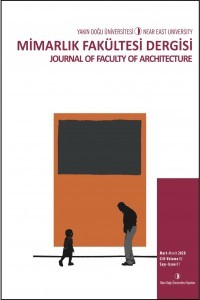Dostluğa ve Alçakgönüllülüğe Övgü ‘Mimarlığı Öncesiyle Kuşatmak’
Dostluk, Alçakgonüllülük, Ziya Tanalı, Mimarlık, Felsefe, Niş
Encomium on Friendship and Humility ‘Embracing Architecture with its Preliminaries
Friendship, Humility, Ziya Tanalı, Architecture, Philosophy, Niche,
___
- Akcan, E. (2018). Open Architecture: Migration, Citizenship, and the Urban Renewal of Berlin-Kreuzberg by IBA-1984/87. Basel: Bikhaeuser.
- Aristoteles. (2004). Nichomachean Ethics. (J. A. . Thomson, Trans.). Penguin Books.
- Benveniste, E. (2016). Dictionary of Indo-European Concepts and Society. (E. Palmer, Trans.). Chicago: Hau Books.
- Deleuze, G. (2003). İki Konferans: Yaratma Eylemi Nedir? Müzikal Zaman. (U. Baker, Trans.). Norgunk.
- Deleuze, G., & Guattari, F. (2015). What is Philosophy? (G. Burchall & H. Tomlinson, Trans.). Verso.
- Lambert, G. (2017). Philosophy After Friendship. Minneapolis: University of Minnesota Press.
- Kimse kendi topraklarında peygamber değildir.
- Landrum, L. (2012). “The Beginnings of Architectural Theory in Drama and Philosophy. Warehouse Journal,” 212–217.
- Lefaivre, L., & Tzonis, A. (2004). The Emergence of Modern Architecture: Documentary History From 1000 to 1810. London ; New York: Routledge, Taylor & Francis Group.
- McEwen, I. K. (1993). Socrates’ Ancestor. MIT Press.
- Onur, Z. (Ed.). (2010). Ziya Tanalı. TMMOB Mimarlar Odası.
- Palasmaa, J. (2018). Cool Passions: Reason and Emotion in the Architecture of Manuel Cervantes. El Croquis, 193(1), 22–27.
- Parcell, S. (2012). Four Historical Definitions of Architecture. McGill-Queens University Press.
- Prown, J. W. C., & E. Denavit, K. (Eds.). (2014). Louis I. Kahn in Conversation: Interviews with John W. Cook and Heinrich Klotz, 1969-70. The Yale Center of Art, Yale University Press.
- Zafiris, E. (2019). The Static Tripod and its Diachronic Stability. Retrieved from http://www.attp.tuwien.ac.at/sophistication3
- ———. (2020). Natural Comunication: The Obstacle-Embracing Art of Abstract Gnomonics. Birkhaeuser.
- ISSN: 2687-2757
- Başlangıç: 2019
- Yayıncı: Yakın Doğu Üniversitesi
Dostluğa ve Alçakgönüllülüğe Övgü ‘Mimarlığı Öncesiyle Kuşatmak’
Feodalizm Dönemi Azerbaycan Mimarisinde Renk ve Işık
Aysel MİRKASİMOVA, Rana AMRAHOVA
Hande Sanem ÇINAR, Nilüfer Kart AKTAŞ
Karizmatik Bir Figür olarak “Starchitect”
Sahiciliğin Sadeliği: Ziya Tanalı’nın Etiği ve Japon Estetiği
